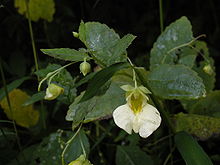Impatiens pallida
| Pale jewelweed | |
|---|---|

| |
| Impatiens pallida | |
| Scientific classification | |
| Kingdom: | |
| (unranked): | |
| (unranked): | |
| (unranked): | |
| Order: | |
| Family: | |
| Genus: | |
| Species: | I. pallida
|
| Binomial name | |
| Impatiens pallida | |
Pale jewelweed, pale touch-me-not or yellow jewelweed (Impatiens pallida) is a flowering plant native to Canada and the United States. It grows in moist to wet soils, generally alongside the closely related Impatiens capensis, producing flowers from midsummer through fall. Along with other species of jewelweed or "touch-me-not", it is a traditional remedy for skin rashes, although controlled studies have not shown efficacy for this purpose.[citation needed]
Pollination
Nectar spurs are tubular elongations of petals and sepals of certain flowers that usually contain nectar. Flowers of Impatiens pallida have nectar spurs which are thought to have played a role in plant-pollinator coevolution. Most of the nectar spurs of Impatiens pallida are perpendicular but some of them are curved.[1]
These nectar spur flowers are either partially or completely pollinated by insects. The specific pollinator is determined by the curvature of the nectar spur. Since Impatiens pallida have perpendicular nectar spurs, bees are the main pollinators.[1]
References
External links
- Connecticut Botanical Society: Impatiens pallida
- Plants For A Future: Impatiens pallida
- USDA Plants Database: Impatiens pallida
